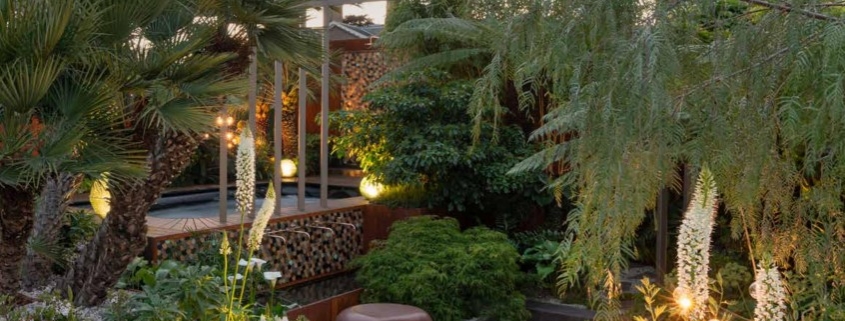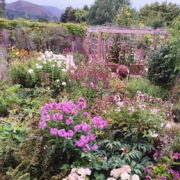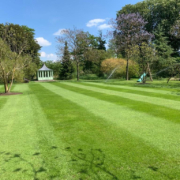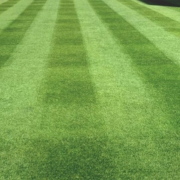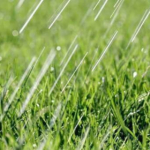The Gould standard
The Gould standard: Kate Gould, a six time Chelsea Gold Medallist, took time to speak with Scott MacCallum. Photographs by Helen Fickling.
Do daffodils come in Blue?” That’s not the sort of question you’d necessarily expect to see posed in one of the country’s foremost landscaping magazines, but it was actually the very kind response to a warning to my latest interviewee that I might be asking a question that may be one of the stupidest she’d ever been asked.

The Gould standard
“Oh, that’s unlikely,” said six time Chelsea Gold Medallist, Kate Gould, before explaining that she had been asked about the colour options for one of the nation’s favourite flowers. Wordsworth would be turning in this grave.
I wandered lonely as a cloud
That floats on high o’er vales and hills
When all at once I saw a crowd
A host of Blue daffodils
Doesn’t work at all.
As for my potentially stupid question, we’ll come to that later, but, fortunately for me, it appears that Kate was either being kind or didn’t consider it to be one of her top 10 daft questions.
Londoner Kate is renowned for her small city gardens, but she doesn’t limit herself or her team to that one genre, she will tackle any project, big or small.
“I can be running anything from 20 to 40 jobs at any one time and we will do small planting jobs, big planting jobs as well as full gardens.
I do like the variety and, while what we do can be quite elitest and often requires quite a lot of money, if we can make something work for someone who has a reasonable budget we will go in and do it,” explained Kate, adding that she has a team of 17 to 18 strong which needs to be kept busy.
With a huge whiteboard dominating the office upon which it is currently impossible to add even the smallest of jobs, being kept busy seems to be the least of the challenges for Kate Gould Gardens.
It’s a far cry from when she started off as a one-woman band over 20 years ago, but unlike many who, as a business grows, finds themselves up their ears in financial spreadsheets, health and safety and human resource issues, Kate makes time to ensure she still gets her hands dirty.
“I do spend a lot of my time not designing gardens and not planting, but instead sitting at my desk crunching numbers, but I do try to be on site if we are planting. I’ll be in the back of the lorry. You can’t stop me, much as though the guys would like to!”
Kate comes from a family of keen gardeners and it was a career in garden design which won over studying to become an archaeologist, when it came to a battle of hearts and minds.
“I loved history, but someone once said, given what I do now, that I must have been attracted to being up to my knees in mud. Basically I haven’t grown out of making mud pies!”
With archaeology set to one side Kate freely admits that she had little clue to what she was doing when she started out in the garden design business.

The Gould standard
“I was 23 and had absolutely no idea what I was doing. I placed a small ad in Gardeners’ World magazine and managed to get a job through that, while I got another job through my tutor.”
Ah, that tutor. Often success or otherwise can come down to those sliding door moments and one of Kate’s came when she started to take Garden Design evening classes and was given a tutor who subsequently has shaped her professional life.
“I struck gold because my tutor was absolutely awesome. That was 25 years ago and she was the one who insisted that I give Chelsea a go. She nagged me about it being time, to the extent that it planted that seed in my head. That was very important to me.”
Those early days are so valuable to any landscape designer, although perhaps not in monetary terms.
“We were talking only yesterday that we had a quote in for a job and that it was for twice my first year’s turnover and now I turnover more in a day than I did in my entire first year in business,” said Kate, in a manner which focuses more on the pride of surviving that first year than it does the success she now enjoys.
That element of self-deprecation is even more evident when asked when it was that she first realised that she excelled at garden design.
“I don’t think I ever have,” spoke the six-time Chelsea Gold Medallist, with a degree of melancholy.
“No honestly. Every day is a school day. I’m constantly questioning and you are only as good as your last garden. I’m pretty sure I’ve got imposter’s syndrome.”
But surely six Gold Medals, including a top honour Best in Show, must count for something? “Maybe I got the judges on a good day.”
She is quite clearly wrong, but it is refreshing, and very much at odds with the current modern culture, which sees so many wannabes pushing themselves in front of cameras, only for them to confirm what we already all suspected, that they had no discernible talent whatsoever.
Chelsea is one occasion when Kate does have that spotlight on her, but even then it is the process and collaborative nature of designing and building a garden which rocks her boat more than the end result.
“I love Chelsea because I love the feeling of creativity and teamwork that you get and I’m very fortunate to work with a bunch of people who also love it. We bounce off each other and create things which are perhaps different to what other people have seen and which other people might be too scared to build. That might be why we have Gold Medals,” said Kate, who added that while she and her team did do three Show Gardens, in 2018, including Chelsea and Singapore, it took three months out of the year.
“We now try to stick to one a year.” While the building element is a highlight, waiting to discover the judges’ verdict is very much a lowlight.
“There is no worse feeling than standing outside your garden waiting for the judges to come round. It’s vile, you literally want to vomit. It’s worse now because in the last few years they come with the BBC who stick a camera in your face. I’ve actually perfected a technique of dropping in the odd expletive to ensure that the footage can’t be used, particularly if I’ve been disappointed and on the verge of tears,.
Her first visit to Chelsea brought a Silver Medal, which would have pleased many, but not Kate.
“I was disappointed at the time, but it was actually a massive learning curve. The judges said that my water feature looked like a cash point machine… And it did!”
With such a successful CV, those disappointments have been rare. Gold Medals in ‘07, ‘09, ’13, ’17, ’18 and ’22, place her in the upper echelons of the business and she knows very much what is expected to hit the mark.
“You know pretty much within the first week of building a garden. If your plants are good and you hit your brief you kind of know what to expect in terms of medal. We are self-judging the whole time. I’ve had feedback from judges which has seemed unpalatable but then gone away and thought about it, and a few months later concluded that they were probably right,” she confessed.
“I’m not competitive at all but put me on a showground and I become, quietly, the most competitive person you can imagine. It brings out the worst in me.”
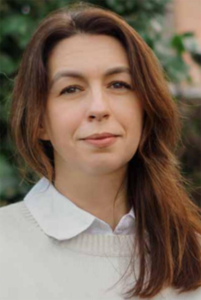
The Gould standard
If the industry suffered during the pandemic is was nothing more than a glancing blow as people became much more appreciative of their homes – inside and out.
“I think the gardening world kept the economy going, during those dark times.
“We all did quite well, but there has been a slow down as people don’t have as much money as they had before. But if you are wealthy you don’t feel it and those clients tend not to go away.”
She is also grateful that clients are so willing to accept the upheaval that garden design brings.
“We are in people’s faces as landscapers. Often we have to go through their houses to get to the garden and it’s not a quick process. It’s a mission and we can be there for months building a garden.
We never want to outstay our welcome but always want to make the best job we can,” said Kate.
So, what of my potentially stupid question?
Here it is.
Is there actually a medal, or is it just a certificate with an embossed medal on it?
Kate, showing great patience.
“No, there is an actual medal, but you only get one the first time you win. After that it is a certificate with the medal painted on it. The actual medal comes in a little 10cm by 10cm box and as far as I know it’s real gold,” she explained, adding that her certificates are up on the wall while the medal is tucked away somewhere in a cupboard.
Now it may be that there are nurseries or laboratories around the world working on a blue daffodil, in which case, I will go up a place in Kate’s list of top ten of stupid questions, but until then I’m quite satisfied that I managed to get away with it.


